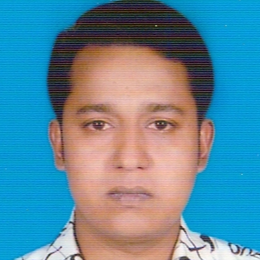
Abu Sayem Mohammad Delowar Hossain
Work place: Department of Computer Science and Engineering, Mawlana Bhashani Science and Technology University, Santosh, Tangail-1902, Bangladesh
E-mail: uzzal35@yahoo.com
Website:
Research Interests: Data Mining, Image Processing, Image Manipulation, Image Compression, Embedded System, Computer Vision, Computer systems and computational processes
Biography
A. S. M. Delowar Hossain was born in Manikganj, Dhaka, Bangladesh and received the B.Sc Engg. & M.S degree in Computer Science & Engineering from Islamic University of Technology (IUT), Gazipur, Dhaka, Bangladesh. He is currently working as an ASSISTANT PROFESSOR at Computer Science & Engineering department in Mawlana Bhashani Science and Technology University, Santosh, Tangail, Dhaka, Bangladesh. He joined in this department as a lecturer and after three years, he is working in this same department as an assistant professor. He has about seven years experience in both teaching and research. His research interests include data mining, cloud computing, embedded operating system, digital image processing and computer vision. Prof. Hossain’s has many international journal and conference publications all over the world.
Author Articles
Analysis of QoS in Software Defined Wireless Network with Spanning Tree Protocol
By Rafid Mustafiz Abu Sayem Mohammad Delowar Hossain Nazrul Islam Mohammad Motiur Rahman
DOI: https://doi.org/10.5815/ijcnis.2017.06.07, Pub. Date: 8 Jun. 2017
Software Defined Network (SDN) is more dynamic, manageable, adaptive and programmable network architecture. This architecture separates the control plane from the forwarding plane that enables the network to become directly programmable. The programmable features of SDN technology has dramatically improved network efficiency and simplify the network configuration and resource management. SDN supports Open-Flow technology as forwarding function and centralized control successfully. Wireless environment has recently added to the SDN infrastructure that has rapidly emerged with Open-Flow protocol. To achieve more deterministic network behaviors, QoS provisioning is a necessary consideration. In this paper, the Spanning Tree Protocol (STP) has applied on a SDWN and then analyzed the Quality of Service (QoS) using Mininet-Wifi. STP protocol is used to suppress the occurrence of broadcast streams and observe the performance of the QoS parameters. Various parameters that determine QoS, such as, bandwidth utilization, packet transmission rate, round trip time, maximum obtained throughput, packet loss ratio, delay time is analyzed for different base stations defined in the SDWN architecture.
[...] Read more.Automatically Gradient Threshold Estimation of Anisotropic Diffusion for Meyer’s Watershed Algorithm Based Optimal Segmentation
By Mithun Kumar PK Md. Gauhar Arefin Mohammad Motiur Rahman Abu Sayem Mohammad Delowar Hossain
DOI: https://doi.org/10.5815/ijigsp.2014.12.04, Pub. Date: 8 Nov. 2014
Medical image segmentation is a fundamental task in the medical imaging field. Optimal segmentation is required for the accurate judgment or appropriate clinical diagnosis. In this paper, we proposed automatically gradient threshold estimator of anisotropic diffusion for Meyer’s Watershed algorithm based optimal segmentation. The Meyer’s Watershed algorithm is the most significant for a large number of regions separations but the over segmentation is the major drawback of the Meyer’s Watershed algorithm. We are able to remove over segmentation after using anisotropic diffusion as a preprocessing step of segmentation in the Meyer’s Watershed algorithm. We used a fixed window size for dynamically gradient threshold estimation. The gradient threshold is the most important parameter of the anisotropic diffusion for image smoothing. The proposed method is able to segment medical image accurately because of obtaining the enhancement image. The introducing method demonstrates better performance without loss of any clinical information while preserving edges. Our investigated method is more efficient and effective in order to segment the region of interests in the medical images indeed.
[...] Read more.Other Articles
Subscribe to receive issue release notifications and newsletters from MECS Press journals